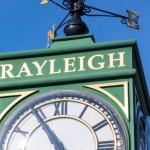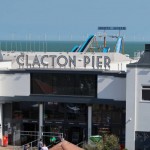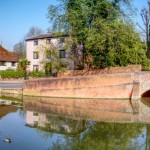Grays, though not often celebrated, is one of the largest towns in the Thurrock area of Essex. It was once a small port town but has grown in significance to be somewhere people are proud to come from.
We wanted to know all about Grays, and whether it is a potential holiday destination. Let’s hop on the staycation destination express and explore all there is to know and love about Grays.
The Early History of Grays
The Parish registers of Grays Thurrock date to 1674, but we know that it existed during the times of the Domesday Survey, in 1086. In the time of the Normans, Grays was already one of the top 20% of settlements in the Domesday Book. It must have existed for some time before that. A third source we consulted has the beginning of the town in 1195 when the first Gray bought Thurrock manor.
We know the Domesday recordings are correct, so we know that Grays existed in 1086. Further, we can see in the Domesday Survey entry for this town that it existed in 1066, 20 years earlier, as they also recorded the worth of the land before the Normans took over. In 1066, Grays belonged to Alward the Noble.
In 1086, the town had five recorded owners and 110 people living in it. Three of those owners are listed as the Land of Bishop Odo of Bayeux, the maternal half-brother of King William the Conqueror. He would die in 1195, only 9 years after the survey was taken. While he was alive though, he owned 10 smallholders, 2 villagers, 16 acres of meadows, 100 sheep, 30 pigs, woodland, meadows, cattle, and other things.
The other two owners of Grays were Robert Count of Eu, who owned 17 villagers, 45 smallholders, and 8 slaves (let us never forget that our ancestors kept slaves), 500 sheep, 2 fisheries, woodland enough for 200 pigs and 18 plough teams for his 40 acres of meadows.
William Peverel was the final owner, with 7 plough teams, 100 sheep, 1 fishery, 18 smallholders, 2 slaves and 5 freemen, among other things.
All of this would have formed a good basis for the large town we know and love today, but sources have Grays as a small town up until the Industrial Revolution when its population exploded. In 1195, Henry de Grai was gifted the manor house at Thurrock by Richard I. For a time, the town would have been peacefully trundling along.
The next part of Grays history isn’t so fantastic, so let’s stop for a moment and appreciate all the fun facts and trivia we could dig up about the place, instead.
A Bit of Grays Trivia
Whether you live there or are in town for a party, you should memorise a few fun facts that will make you look like you know your stuff. Here are the Five Minute Spare favourite facts about Grays for your enjoyment:
- The Thurrock region is 70% green belt area. Its situation outside of London makes for a pleasant country trip by train to the coast.
- Grays is the site of the biggest murder investigation known to the Essex police department. In the early 2000s, a truckload of 39 people was discovered here. It is believed that they were asylum seekers, smuggling themselves into the country. When the lorry was opened, they were all found to be dead. Men, women, and children. Two men were charged with their deaths[i].
- Most of Grays was built between 1871 and 1893 when rapid housing was erected to provide workers for the chalk pits.
- The ONS once voted Thurrock as the ‘capital of misery’ in the UK. The average life satisfaction rating here is 7.09. Out of 100[ii].
- The southeast of England, where the satisfaction of life rating is at its lowest, is where the English Defence League and the BNP hail from. It is also one of the places on the coast where you may see a boat of refugees.
On that cheery note, let’s turn our attention away from the misery of the people here and back towards the not-so-happy history, instead.
Grays in the Medieval Period
We really don’t know much about Grays during medieval times. We found a reference to the parish history that commented on 24 Grays men being assessed by the lay subsidy in 1327. This meant that the town had more taxpayers than the average place. While it became urbanised in this time, and in the early 14th century, that same source[iii] says there was little growth in the following few centuries.
The town wharf was erected in the medieval period and the control of it fell to the Lord at Thurrock. The Lord of the Manor owned the ferry rights and would receive a customs tax on all goods shipped in and out of the port. In 1228, during the reign of Henry III, a complaint was raised against Richard de Grai as locals said his taxes were too high.
In 1559, someone had the idea that the cargos coming and going from the wharf should be recorded. As such, there are some notes on what came and went from then onwards. We know from these records that the Long Ferry boats out of Lion Key would deliver goods to the wharf almost daily.
In 1756, the Court Leet records some of the traffic going through the wharf and it is quite impressive. The Lord was James Theobald at that time, and he charged:
- 1d for a cauldron of coals
- 2d for a hog
- 4d for a load of straw
- 6d for 1000 bricks
- And soldiers with their baggage and equipment at 2.20d[iv]
In 1841 a second pier was added for further trade, but we are getting a little ahead of ourselves. What we need to know about medieval Grays seems to be tied to the wharfs. It was a steady port town that didn’t see all that much growth until the industrial era.
Industrial Era Grays
It was during the Victorian age that the strange history of the town begins. From the 17th century onwards, chalk was found in the area and pits were dug to remove it and process it. The town would have been covered in fine white dust, with three large chalk pits in place by the start of the 1800s.
To this day, most of the new homes built in this period to accommodate the workers are at risk of sinkholes. The buildings were built at the end of the Victorian period and right on top of the old chalk pit. If you live in Grays right now, then you are likely living on an old chalk quarry. The area which can still be seen is known as Gray’s Gorge, although it was formerly called “Grays chalk quarry”. There were three big ones in the area, the Duvals Pit and the Titan Quarry being the other two. By 1871, owner Richard Meeson had built a tunnel to connect both quarries, where Hogg Lane is. The quarries produced ‘Whiting’ a substance used in paint, putty, and around the house, up until the Second World War.
If you live in the area and want to learn more about it, this entry in the Essex Field Club of geologists explains it better than we can. It’s a fascinating area – but lots of those houses were built on considerably faulty land. If you are moving to Grays, get a survey done.
One last comment about the geology before we move on. The quarries around the town brought up evidence of several creatures which once lived in the area. Some of the fossils produced included wild cat, hyena, wolf, bear, bison, hippopotamus, rhinoceros, and even mammoth![v]
In 1898, Grays Town Council bought 8.25 acres of land to build council offices, the well-known Grays Park, and a stable for their vehicles. The Park was shored up on two sides by concrete walls because, at the time, it was slipping into the old quarry. Ivy was planted to disguise all that concrete and a bandstand was built for the Grays families[vi].
In 1903, a makeshift beach was added on the banks of the River Thames, with the intention of making use of the mudflats. A pool was excavated to use the material to raise the river wall, and children would swim there in summer. In 1912 the pond saw daily use, all summer long. By 1999, it had been considered a safety hazard and infilled, but they turned it into the playpark on the river’s edge, so it wasn’t a complete loss.
As well as having extensively excavated chalk quarries on all sides, Victorian-era Grays had brickwork, where they made bricks that would be shipped down the Thames for use to build industrial London.
By 1801 there was a population of 677. In 1871, the population was 2,806. In 1901, this number was an impressive 13,543, and was 18,173 by 1930, despite having sent many of their young men off to war. Between 1871 and 1893, more than a thousand houses were built, mostly all in the ruins of the old quarries which had now permanently scarred the landscape. By 1903 there were 2,507 houses, with a post office added in 1838. A telegraph office followed in 1874 and the old timber-framed buildings in the high street were still in use right up until the 1950’s.
Modern Era Grays
The Empire Theatre was built on the high street in 1910. A Ritz cinema was built on the New Road in 1940 and the Empire closed in ’42. A navy ship called ‘Goliath’ was moored in the wharf in 1835 and served as an open ship that schools could tour. It was destroyed by a fire in 1875, killing an officer and 18 young boys. The Shaftesbury was opened after her in 1893 but was closed by 1939. The Cutty Sark was in Grays in 1947 briefly, too.
During WWI, Grays contributed immensely. Some 305 young men from the town died and their lives are commemorated in the war memorial unveiled by the council in 1921, Lest We Forget. During WWII, Grays’ proximity to London and the Tilbury Docks made it a frequent target for bombers. One eyewitness[vii] recorded that the children were so used to hearing the doodlebugs dropped that they knew to listen for the noise of them – and that if the noise stopped, they had ten seconds to get to shelter or risk being caught in the explosion. Children also had routine gas mask practise and were often wakened in the night to get to the air-raid shelters.
After the war, Grays continued to grow slowly. The Thurrock Orchestral Society was founded in 1946 and the Grays Choral Society shortly followed. The former Regal Cinema became a bowling alley and was later demolished, with the Ritz becoming a bingo hall. A public library was added in the 1970s, and the old high street was extensively rebuilt in the same decade.
Modern Grays is a seemingly bleak place to live, despite having its own beach and some fascinating geology surrounding it. Asides from being a port town on the Thames, it is in the centre of marshy lands at the bottom of old quarries, making it a stunning habitat filled with wild birds and exemplary Green Belt land. The old quarries have been reclaimed by nature, adding a touch of greenery to a long overworked land.
It’s a quiet town that people say is a great place to raise children. We only wish we could do something to help the people there live happier lives…
Famous People who Come from Grays
Given its long history as a quarry town, Grays is bound to have thrown out a few interesting famous people in the last few hundred years. We collated some of our favourites, so you don’t have to hunt for the answers…
- Russell Brand, love him or hate him, is from Grays
- Ian Abercrombie, an actor based in America but born here
- Comedian Joe Pasquale is from Grays
- A swathe of footballers, including John Page, William Kennedy, Archie Clement and Lloyd Butler
- Edmund Wright Brooks, who you have never heard of, but who was one of the noblemen who helped to end slavery in Britain.
- A swathe of retired footballers, including Micky Ingwell, Keith Day, Steve Crane, and Greg Berry.
Let’s move swiftly on to the best things to see and do if you are in Grays.
Things to see and do in Grays, Essex
We researched the best things to see and do in Grays, so you have no reason not to visit.
Historical Sights and Landmarks
There’s an upside-down house in Grays. The Lakeside upside-down house is the second attraction of the upside-down house company, here in the UK. You will find it near the Lakeside Shopping Centre situated inside its own outdoor amphitheatre. This is where you find all the cool kids in town, taking pictures for their Instagram.
Although it might be an unusual landmark, the Aqua Park Lakeside is a big waterpark that is on the edge of the Thames. The water park area itself has been in use as a recreational area by the people of Grays since it was scooped out in the Industrial Era. It contains 30 ‘inflatable obstacles’ for you and your family to enjoy.
When you visit Grays you aren’t so far from two old forts that are worthy of your attention. The Coalhouse Fort is an artillery fort that was built in the 1860s. The mouth of the Thames, where eastern Essex sits, was always at risk of attack from ships. The Coalhouse Fort was built as an arms repository to be used in case of attack.
Tilbury Fort, on the other hand, would house the soldiers when the Thames Estuary was under attack. It is a marvellous construction, built on an island in the waterways, and has seen use from the 16th century right up until the Second World War. It’s now run by English Heritage, so we recommend you visit and donate to keep attractions like this alive.
Galleries and Museums
If you get a chance and you like art, check out what’s on at Grays Wharf while you are in the area. They often run exhibits of both local art and pieces from farther afield. They provide a few self-contained studios for artists who want to rent a space and offer residencies for some of the best curators in the area.
Kids and adults both love the Essex Fire Museum. They have fire trucks from throughout the ages and lots of historic equipment on show. They have uniforms and photographs, machines to play in, and lots of history for you to find out about.
The people who really know when the town was founded, can be found themselves at the Thurrock Museum. Apparently, they can date the history of the land and settlements on it back 250,000 years. They have prehistoric flint tools and fragments of Roman pottery here.
Sports and Recreation
Take the youngsters to the Partyman World of Play centre and let them work off some of that energy. This indoor soft play zone is amazingly big, with a café included so you can sit it out for a while. It’s a brightly coloured fun zone suitable for kids of all ages, although around 11 they start to like Xbox more.
If you prefer your tastes a little more refined, head for a show at the Thameside Theatre. This place is especially hot during panto season, so book early. The theatre has been closed due to Covid-19 but there are no plans to close it permanently.
Most English towns have three golf clubs, Grays has four. Visit Orsett, American Golf, Mardyke Valley, or the Belhus Park Golf Clubs for a few holes.
Grays have their own rugby club and several youth football clubs. Grays Athletic are the local team but Grays Thurrock United FC were their predecessors.
Outdoor Attractions
Most definitely have a hike through the Essex Wildlife Trust owned Chafford Gorges Nature Park. This is the entire area of the old quarry, which has been reclaimed and is teeming with wildlife. From birds to badgers, you will find it in this green belt area.
You do not come to Grays without visiting Grays Beach, which is the manmade beach built by the Victorians. It’s situated on the edge of the Thames and contains a beachy play park and picnic area. This place is mobbed on Saturdays and in good weather.
Other Things to See and Do in Grays
We couldn’t fit all the things there are to do here in one place, but we have tried to squeeze in a few more things to do in Grays, should you have the time.
- Go to DiveMania and take a scuba diving or snorkelling lesson
- Hit the trampoline park at Jump Giants Thurrock for a good time jumping
- Leave the teens at Belong by Game where they can have the modern version of a LAN party
- Call Adventure Activities Essex and book an adventure
- Visit St Peter and St Paul’s Church if you like that sort of thing
How to Get There?
How do you get to Grays then, now that you are so excited to go there? Follow these loose directions and hope.
By road
Follow the Thames west out of London on the A13
By rail
Look for Grays Station on the southern line
By air
London City Airport is the closest
By sea
The Tilbury London Port is closest.
Not the Destination for You?
If Grays seems a little lacking in joy for you, there are plenty of travel destinations throughout the UK (and beyond) over on our website. Don’t forget to catch us on Instagram, too. Have fun exploring!
[i] https://news.sky.com/story/essex-lorry-deaths-two-men-found-guilty-of-manslaughter-of-39-vietnamese-migrants-12147394
[ii] https://www.theguardian.com/lifeandstyle/2012/jul/25/thurrock-capital-misery
[iii] https://www.british-history.ac.uk/vch/essex/vol8/pp35-56
[iv] https://www.thurrock.gov.uk/history-on-river-thames/grays-wharf
[v] https://www.british-history.ac.uk/vch/essex/vol8/pp35-56
[vi] https://www.thurrock.gov.uk/history-on-river-thames/grays-park-and-beach-in-victorian-and-edwardian-times
[vii] https://www.bbc.co.uk/history/ww2peopleswar/stories/56/a1949556.shtml





